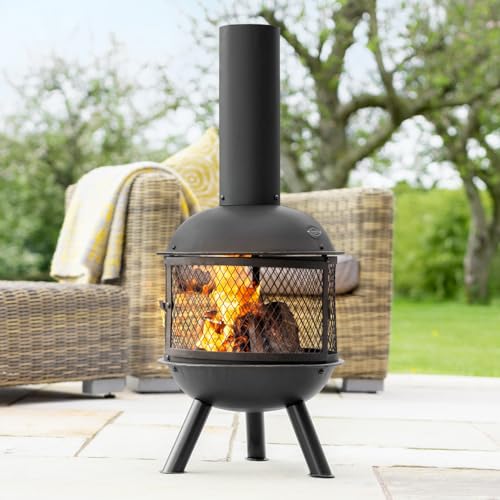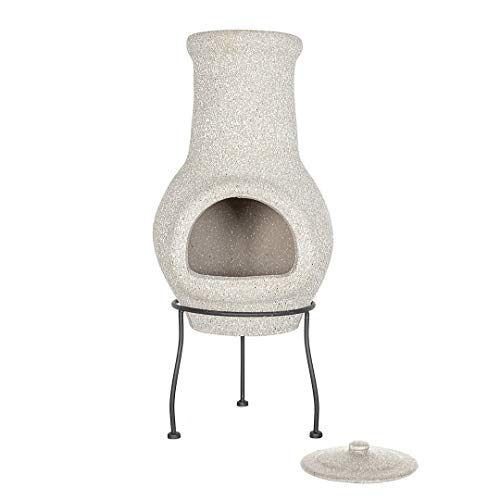9 . What Your Parents Taught You About Chiminea Terracotta
페이지 정보

본문
 A Chiminea Terracotta Adds Warmth and Ambiance to Your Backyard Patio
A Chiminea Terracotta Adds Warmth and Ambiance to Your Backyard Patio A chiminea adds warmth and an atmosphere to your backyard. Its chimney directs smoke upwards to prevent sparks and flames from damaging surrounding plants and igniting your home or deck.
A chiminea adds warmth and an atmosphere to your backyard. Its chimney directs smoke upwards to prevent sparks and flames from damaging surrounding plants and igniting your home or deck.Chimineas made from clay should be broken in slowly. The first few flames should be slow and small. Sealing a chiminea is recommended, especially in rainy climates.
Material
A chiminea can add charm and warmth to any patio. The pot-belly design of a Chiminea is great for entertaining. However, new designs are now available to fit a variety of decor styles. While clay is the most common material, chimineas can also be available in cast iron and aluminum. Each type of material has its own advantages. While clay is easy to maintain, metal is more durable and better at enduring high temperatures.
When selecting a chiminea to purchase, consider its size, design and the type of fuel. Its size should be able to accommodate the amount of wood you'll be using to keep it burning at a constant temperature. Larger models may be more suited to family gatherings and smaller models are better for intimate locations. A chimney is a way to direct smoke upwards and shields it from rain and powerful winds.
The design of a chiminea distinguishes it from other fire pits that are used outdoors. The bowl-shaped base shields the flames from wind, rain and debris. The chimney is attractive and allows you to regulate the size of the flames.
Clay chimineas can be shaped by hand, and then fired at high temperature. They are often coated with a Ceramic chimineas glaze in order to make them more appealing and durable against weather damage. Some are decorated with Mexican-inspired motifs. Chimineas are available in home improvement centers.
Before lighting a chiminea, you must cover the inside of the chiminea with coarse-grained gravel or sand. The sand helps reduce smoke and also prevents the clay from cracking when fired. Once you've covered the base, put a few small pieces of kindling at the center. Use a natural fire pit with chiminea lighter like this one from Amazon to make it easier to light.
When you are ready to cook Use a long-handled fork or spatula to turn the hot embers. Cooking food should not be done in direct flames since it could cause burning and cause the food to blacken beyond recognition. Start with a small fire and build it up slowly. Then, transfer the cooking pan to the top of the smoke stack.
Design
A chiminea is a fire pit that appears like a potbelly stove with a wide bottom, with a mouth for the fire and a long, narrow chimney for smoke. The chimney also shields the fire from the rain and wind and can also extinguish a more open fire pit. Since over 400 years, Chimineas are used to cook and gather as well as for heating homes. Originally handmade of clay, they're now available in cast iron or terracotta with modern and traditional styles.
Modern chimineas may not feature the traditional curves, but they have distinctive chimneys. They are available in various shapes and sizes, from 12 to 16 inches at the base and 25 to 30 inches high (including stands). The chimney usually rises about 6 feet.
The height of a chiminea's eave is important because it helps direct smoke upward, which can prevent it from blowing onto people and things in your backyard or home. It also allows you to use aromatic woods that will smell great when they burn, adding to the enjoyment of sitting around a fire.
When you're choosing a chiminea make sure you choose one made of durable material that can withstand extreme temperatures. Avoid models with ornaments or features that could crack or break when heated. If you decide to use a clay or terracotta chiminea is to be seasoned, it must be done by burning small amounts of wood for three to four fires until the clay is able to become cured. The chiminea should be protected by a lid when not being used to prevent water from spilling over the flames and burning it.
Cast iron chimineas are more heavy and more durable than clay models, meaning they can handle higher temperatures and more rough handling. They also tend to be more versatile since they can burn briquettes, coal, or briquettes in addition to wood. If you want traditional design, you can choose the clay chiminea.
No matter what material you choose, make sure that you place your extra large chiminea in a safe distance from your home and all outdoor furniture. The chiminea should also be located at least 10 feet from any other structures such as a fence or shed. Create a hearth in your patio using pavers to create an ideal platform to put your chiminea and make it easier to control the flame.
Installation
A chiminea can be the focal point of any family gathering and adds a new dimension to outdoor spaces. However, just like any fire pit or fireplace, it is important to be aware of the maintenance requirements prior to purchasing one. Cast iron chimineas are more durable than traditional clay chimineas. However, they require slightly different care due to the differences in design.
The first step is to prepare the base of the chiminea. The bottom should be lined with sand, gravel or lava rock in order to keep it from direct contact with the flame. This will help reduce smoke and also prevent the chiminea from breaking.
It is also important to ensure that the chiminea is set up on the ground in a level and secure location. Don't place it on a deck or other flammable surface. If you must place it on a surface that is flammable you can use a metal grates to elevate the wood. This will shield the chiminea from heat and sparks of the fire.
Before you light the chiminea for the first time, it should be seasoned by burning a few small fires inside it. This will stop the chiminea's structure from cracking if you burn a lot of wood.
After each fire clean the chiminea thoroughly by brushing with wire-bristle brushes or a cloth. Also, you should get rid of any creosote or ash inside the chiminea. If these chemicals are not removed, they can impact the quality of any subsequent fires that you put in it.
The chiminea must be sealed with a protective cover when it is not in use. This will prevent the clay from becoming wet and cracking or shrinking. Chimineas are prone to this type of damage if exposed for a long period of time to snow and rain.
The best way to safeguard the chiminea is to leave it covered, even in the summer. It is also a good idea to have a backup source of fuel for the fire, like a propane tank or wood. It is also a good idea keep a fire extinguisher nearby to get rid of any sudden fires.
Maintenance
Despite the varying materials from which chimineas are made They all require regular maintenance to ensure they last as long as possible. This includes cleaning the structure as well as applying protective coatings and properly storing it during the off-season to protect against extreme temperatures. These steps and the basic guidelines for use can prolong the life of your Chiminea and decrease the risk of injury.
Chimineas, which are composed of clay, may crack if exposed to sudden temperature fluctuations. This is why it's important to store your terra cotta in a dry and safe location during the off-season, preferably with a cover that will guard against rain and frost. It's also a good idea to regularly apply a sealant that is protective to your clay chiminea in order to help shield it from the effects of temperature and moisture.
To avoid damaging the clay surface, make use of a non-abrasive material and a soft cloth or brush to clean a chiminea. After you've scrubbed the surface, wash it off using an hose or bucket. Give the chiminea time to dry completely before re-using it. This will stop mildew and mold growth and will keep the chiminea looking new.
If your chiminea has a cracked or damaged section, it is essential to clamp the broken pieces together and then apply outdoor oven cement to the crack. You can buy this at most hardware stores and it needs to be applied with the help of a spatula or pointing trowel. It is essential to allow the cement to completely dry before lighting a test flame in the chiminea.
Once the cement has dried, sand the damaged area of your chiminea medium coarse sandpaper to prepare it for repainting. You can then paint it using more than or less any emulsion paint for masonry or household use in a shade that is similar to the rest of your chiminea. If your chiminea is exhibiting corrosion or rust on it, remove it by sanding the affected areas, then rinsing them with water to rid them of any dirt or dust particles.
- 이전글7 Small Adjustments That May have A big impact In your Daycare Near Me By State 24.12.06
- 다음글Sharia Compliant & Halal Residence Loan & Finance For Muslims 24.12.06
댓글목록
등록된 댓글이 없습니다.

